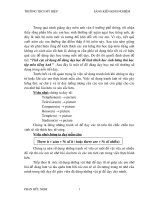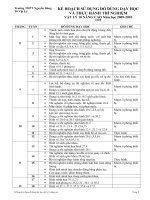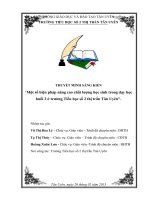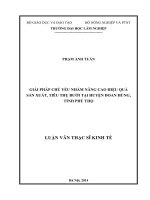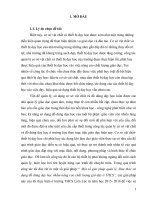Nâng cao DDDH buổi 7
Bạn đang xem bản rút gọn của tài liệu. Xem và tải ngay bản đầy đủ của tài liệu tại đây (313.88 KB, 4 trang )
PRO 3M/3MPLUS – ƠN LUYỆN TỒN DIỆN CHO KÌ THI TỐT NGHIỆP THPT QUỐC GIA
Biên soạn: Cô Vũ Thị Mai Phương – Ngoaingu24h.vn
TÀI LIỆU ĐI KÈM LIVESTREAM
LUYỆN ĐỌC ĐIỀN - ĐỌC HIỂU ( BUỔI 16)
Theo dõi LIVESTREAM ĐỘC QUYỀN của cơ vào lúc
20h30 ngày 9/1/2021 duy nhất trên khóa học PRO 3MPLUS
Cơ Vũ Thị Mai Phương
ai
:T
ge
Pa
Trích đề thi thử lần 2 trường THPT Chuyên Bắc Ninh năm 2021
Read the following passage and mark the letter A, B, C or D on you answer sheet to indicate the
correct answer to each of the questions.
Korea's recent unveiling of the world's first cloned dog was welcomed by King Chow, assistant
professor of biotechnology at the Hong Kong University of Science and Technology, but fie also warned
that we need to be on guard against possible reproductive cloning. Professor Chow went on to explain
that, "The development of the technology is a good thing in itself but how we monitor it and who we
allow to use it will be of great importance".
Professor Chow is one of many academics who feel that a clear line must be drawn between
reproductive cloning and therapeutic cloning. Therapeutic cloning involves the use of embryonic stem
cells to develop human cells or organs that can be used to cure diseases such as Parkinson's and diabetes.
People in wheelchairs may be able to walk again thanks to this technology as scientists believe that they
can clone new cells to repair back and neck injuries.
Reproductive cloning involves implanting a cloned embryo into a uterus in the hope of producing a
healthy foetus. A company called Clonaid claims to have successfully cloned thirteen human babies. They
say that all of the babies are healthy and are in various locations, including Hong Kong, UK, Spain and
Brazil. Clonaid states that they are using human cloning to assist infertile couples, homosexual couples
and families who have lost a beloved relative.
The same technology can be used for animal cloning. If endangered species such as the giant panda
and Sumatran tiger could be cloned, they could be saved from extinction. Livestock such as cows could
also be cloned to allow farmers to reproduce cattle that produce the best meat and most milk. This could
greatly help developing countries where cows produce significantly less meat and milk.
Question 1. What does the passage mainly discuss?
A. How the development of technology can be monitored.
B. How different human cloning is from animal cloning.
C. Two different types of human cloning technology.
D. A famous scientist working on cloning technology.
Question 2. According to the passage, which of the following is NOT true?
A. Cloning technology can help cure back and neck injuries.
B. The first dog to be cloned was in Korea.
C. Many countries can use cloning technology to produce more meat and milk.
D. Diabetes can't be cured by using cloning technology.
Question 3. The word "unveiling" in paragraph 1 is closest in meaning to __________.
A. entrance
B. introduction
C. opening
D. promotion
Question 4. According to paragraph 4, what animals are in danger of extinction?
A. cows
B. giant pandas
C. all breeds of tiger D. livestock
eu
Li
K
a
ho
ay
H
oc
H
n
ie
M
im
iK
Ph
an
V
KHĨA HỌC PRO3M/PRO3MPLUS – CHINH PHỤC ĐIỂM 9+ MƠN TIẾNG ANH CÙNG CÔ VŨ MAI PHƯƠNG
PRO 3M/3MPLUS – ƠN LUYỆN TỒN DIỆN CHO KÌ THI TỐT NGHIỆP THPT QUỐC GIA
Biên soạn: Cô Vũ Thị Mai Phương – Ngoaingu24h.vn
ai
:T
ge
Pa
Question 5. The word "it" in paragraph 1 refers to __________.
A. reproductive cloning
B. the development of cloning technology
C. Hong Kong University of Science and Technology D. the first cloned dog
Read the following passage and mark the letter A, B, C or D on you answer sheet to indicate the
correct answer to each of the questions.
In our connected globalized world, the languages which dominate communications and business,
Mandarin, Hindi, English, Spanish and Russian amongst others, are placing small languages spoken in
remote places under increasing pressure. Fewer and fewer people speak languages such as Lili, Taushiro
and Dumi as their children shift away from the language of their ancestors towards languages which
promise education, success and the chance of a better life. While to many parents, this may appear a
reasonable choice, giving their offspring the opportunity to achieve the sort of prosperity they see on
television, the children themselves often lose touch with their roots. However, in many places the more
reasonable option of bilingualism, where children learn to speak both a local and a national language, is
being promoted. This gives hope that many endangered languages will survive, allowing people to
combine their links to local tradition with access to wider world culture.
While individuals are free to choose if they wish to speak a minority language, national governments
should be under no obligation to provide education in an economically unproductive language, especially
in times of budget constraints. It is generally accepted that national languages unite and help to create
wealth while minority regional languages divide. Furthermore, governments have a duty to ensure that
young people can fulfil their full potential, meaning that state education must provide them with the ability
to speak and work in their national language and so equip them to participate responsibly in national
affairs. People whose language competence does not extend beyond the use of a regional tongue have
limited prospects. This means that while many people may feel a sentimental attachment to their local
language, “their government's position should be one of benign neglect”, allowing people to speak the
language, but not acting to prevent its eventual disappearance.
Many PhD students studying minority languages lack the resources to develop their language skills, with
the result that they have to rely on interpreters and translators to communicate with speakers of the
language they are studying. This has a detrimental effect on the quality of their research. At the same time,
they have to struggle against the frequently expressed opinion that minority languages serve no useful
purpose and should be allowed to die a natural death. Such a view fails to take into account the fact that
a unique body of knowledge and culture, built up over thousands of years, is contained in a language and
that language extinction and species extinction are different facets of the same process. They are part of
an impending global catastrophe which is beginning to look unavoidable.
Question 6. Which of the following could best serve as the main topic of the passage?
A. The threat to minority languages in different parts of the world.
B. The domination of business languages all over the world.
C. The shift from regional to national languages in many countries.
D. The benefits of national languages in modern world.
Question 7. According to the first paragraph, why do many parents consider the change national
languages a reasonable choice?
A. Because not many people nowadays are familiar with the language of their ancestors.
B. Because children now can learn to speak both a local and a national language.
C. Because their children may have a chance to achieve education, success and better living condition.
D. Because their children may help to combine their links to local tradition with access to wider world
culture.
eu
Li
K
a
ho
ay
H
oc
H
n
ie
M
im
iK
Ph
an
V
KHĨA HỌC PRO3M/PRO3MPLUS – CHINH PHỤC ĐIỂM 9+ MƠN TIẾNG ANH CÙNG CÔ VŨ MAI PHƯƠNG
PRO 3M/3MPLUS – ƠN LUYỆN TỒN DIỆN CHO KÌ THI TỐT NGHIỆP THPT QUỐC GIA
Biên soạn: Cô Vũ Thị Mai Phương – Ngoaingu24h.vn
ai
:T
ge
Pa
Question 8. What does the word “this” in the first paragraph refer to?
A. the more reasonable option
B. the place where children can use bilingualism
C. the opportunity to achieve prosperity
D. the promotion of bilingualism
Question 9. The word “constraints” in the second paragraph is closest in meaning to _________.
A. investments
B. restrictions
C. crises
D. depressions
Question 10. What can be inferred from the sentence “their government's position should be one of
benign neglect" in paragraph 27
A. People who are not members of the government will be allowed to speak their local languages.
B. It's better to allow these minority languages to die naturally by neglecting them.
C. The government does not appreciate the importance of minority languages.
D. The local people will be neglected if they use their ancestors' languages.
Question 11. What is the influence of the shortage of minority language resources on many PhD
students mentioned in paragraph 3?
A. These students are unable to persuade people to use the language they are learning.
B. Their qualified research is unlikely to complete.
C. They will have many difficulties in understanding these languages.
D. They have to become interpreters and translators of these languages themselves.
Question 12. The word "facets" in the last paragraph could be best replaced by _________.
A. aspects
B. problems
C. procedures
D. products
Read the following passage and mark the letter A, B, C, or D on your answer sheet to indicate the
correct answer to each of the questions from 13 to 17
Successful students often do the followings while studying. First, they have an overview before reading.
Next, they look for important information and pay greater attention to it (which often needs jumping
forward or backward to process information). They also relate important points to one another. Also, they
activate and use their prior knowledge. When they realize that their understanding is not good, they do
not wait to change strategies. Last, they can monitor understanding and take action to correct or “fix up”
mistakes in comprehension.
Conversely, students with low academic achievement often demonstrate ineffective study skills. They
tend to assume a passive role, in learning and rely on others (e.g., teachers, parents) to monitor their
studying, for example, low-achieving students often do not monitor their understanding of content; they
may not be aware of the purpose of studying; and they show little evidence of looking back, or employing
“fix-up” strategies to fix understanding problems. Students who struggle with learning new information
seem to be unaware that they must extent effort beyond simply reading the content to understand and
remember it. Children with learning disabilities do not plan and judge the quality of their studying. Their
studying may be disorganized. Students with learning problems face challenges with personal
organization as well. They often have difficulty keeping track of materials and assignments, following
directions, and completing work on time. Unlike good studiers who employ a variety of study skills in a
flexible yet purposeful manner, low-achieving students use a restricted range of study skills. They cannot
explain why good study strategies are important for learning; and they tend to use the same, often
ineffective study approach for all learning tasks, ignoring task content, structure or difficulty.
(Source: Adapted from Study Skills: Managing Your Learning — NUI Galway)
Question 13. What is the topic of the passage?
A. Successful and low-academic achieving students
B. Successful learners and their learning strategies
C. Study skills for high school students
D. Effective and ineffective ways of learning
eu
Li
K
a
ho
ay
H
oc
H
n
ie
M
im
iK
Ph
an
V
KHÓA HỌC PRO3M/PRO3MPLUS – CHINH PHỤC ĐIỂM 9+ MÔN TIẾNG ANH CÙNG CÔ VŨ MAI PHƯƠNG
PRO 3M/3MPLUS – ƠN LUYỆN TỒN DIỆN CHO KÌ THI TỐT NGHIỆP THPT QUỐC GIA
Biên soạn: Cô Vũ Thị Mai Phương – Ngoaingu24h.vn
ai
:T
ge
Pa
Question 14. The word “prior” in the first paragraph is closest meaning to ______?
A. important
B. earlier
C. forward
D. good
Question 15. According to the passage, what can be learnt about passive students?
A. They depend on other people to organize their learning
B. They are slow in their studying
C. They monitor their understanding
D. They know the purpose of studying
Question 16. Which of the followings is NOT an evidence of monitoring studying?
A. Being aware of the purpose of studying
B. Monitoring their understanding of content
C. Fixing up mistakes in understanding
D. Looking at their backs
Question 17. In compared with low-achieving students, successful students use______.
A. aimless study techniques
B. various study skills
C. restricted strategies
D. inflexible study ways
eu
Li
K
a
ho
ay
H
oc
H
n
ie
M
im
iK
Ph
an
V
KHÓA HỌC PRO3M/PRO3MPLUS – CHINH PHỤC ĐIỂM 9+ MÔN TIẾNG ANH CÙNG CÔ VŨ MAI PHƯƠNG
